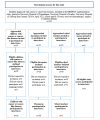Online Ambassador Visits for Hospitalized Children With Cancer: Qualitative Evaluation of Implementation
- PMID: 39231427
- PMCID: PMC11411222
- DOI: 10.2196/53309
Online Ambassador Visits for Hospitalized Children With Cancer: Qualitative Evaluation of Implementation
Abstract
Background: Children with cancer or cancer-like disease risk treatment-related isolation, which can negatively impact their peer relationships and social competencies and exacerbate their loneliness. During the COVID-19 pandemic, increased online socialization became the new normal imposed by national isolation guidelines. To adhere to the treatment-related isolation guidelines, children with cancer were offered online classmate "ambassador" visits during hospitalization.
Objective: This study aimed to identify facilitators and barriers to online classmate "ambassador" visits during children with cancer's hospitalization through a qualitative descriptive process evaluation using the Consolidated Framework for Implementation Research.
Methods: From January to April 2022, we conducted 39 individual semistructured interviews with hospitalized children (n=16), their classmates (n=16), teachers from their schools (n=3), and study nurses (n=4) from involved hospitals. Most interviews (n=37, 95%) were conducted online using Microsoft Teams or Google Meet, while 2 (5%) interviews were conducted in person at the participants' residences. This approach allowed us to gain a broad understanding of the facilitators and barriers to online ambassador visits.
Results: We identified four themes: (1) working together, (2) ensuring participation, (3) staying connected, and (4) together online. The themes are described in terms of facilitators and barriers to online ambassador visits with 3 Consolidated Framework for Implementation Research domains: innovation, individuals, and the implementation process.
Conclusions: Addressing the social needs of hospitalized children through online visits with their classmates may be relevant when one-on-one meetings are problematic. The online visits are highly dependent on collaboration between study nurses and teachers and assessing the needs of the hospitalized children. While a high degree of adult engagement and a stable internet connection are pivotal, these online visits can promote much-needed social interaction between children across physical settings.
Keywords: Children; cancer; in-hospital; interaction; intervention; online; peers; qualiative; quality of life; relationship; school-aged; social.
©Natasha Nybro Boensvang, Mette Weibel, Claire E Wakefield, Pernille Envold Bidstrup, Marianne Olsen, Karin Bækgaard Nissen, Vibeke Spager, Martin Kaj Fridh, Hanne Bækgaard Larsen. Originally published in JMIR Pediatrics and Parenting (https://pediatrics.jmir.org), 04.09.2024.
Conflict of interest statement
Conflicts of Interest: None declared.
Figures
Similar articles
-
School-based interventions for reducing disciplinary school exclusion: a systematic review.Campbell Syst Rev. 2018 Jan 9;14(1):i-216. doi: 10.4073/csr.2018.1. eCollection 2018. Campbell Syst Rev. 2018. PMID: 37131379 Free PMC article.
-
Interventions to support the resilience and mental health of frontline health and social care professionals during and after a disease outbreak, epidemic or pandemic: a mixed methods systematic review.Cochrane Database Syst Rev. 2020 Nov 5;11(11):CD013779. doi: 10.1002/14651858.CD013779. Cochrane Database Syst Rev. 2020. PMID: 33150970 Free PMC article.
-
Facilitators and barriers to the transition from outpatient clinic visits to home-based check-ups for children being treated with growth hormone: a mixed-methods study.Eur J Pediatr. 2024 Apr;183(4):1857-1870. doi: 10.1007/s00431-023-05408-z. Epub 2024 Jan 31. Eur J Pediatr. 2024. PMID: 38294515 Free PMC article.
-
Impact of summer programmes on the outcomes of disadvantaged or 'at risk' young people: A systematic review.Campbell Syst Rev. 2024 Jun 13;20(2):e1406. doi: 10.1002/cl2.1406. eCollection 2024 Jun. Campbell Syst Rev. 2024. PMID: 38873396 Free PMC article. Review.
-
Comparing Two Ways to Help Patients Get Follow-up Care after a Mental Health Visit to the Emergency Room—The EPIC Study [Internet].Washington (DC): Patient-Centered Outcomes Research Institute (PCORI); 2021 May. Washington (DC): Patient-Centered Outcomes Research Institute (PCORI); 2021 May. PMID: 38484096 Free Books & Documents. Review.
References
-
- Dansk Børnecancer Register (DBCR) Resumé af årsrapport 2020-2021. [2024-07-11]. https://ugeskriftet.dk/nyhed/dansk-bornecancer-register-dbcr-resume-af-a... .
-
- Smith MA, Seibel NL, Altekruse SF, Ries LA, Melbert DL, O'Leary M, Smith FO, Reaman GH. Outcomes for children and adolescents with cancer: challenges for the twenty-first century. J Clin Oncol. 2010;28(15):2625–2634. doi: 10.1200/JCO.2009.27.0421. https://europepmc.org/abstract/MED/20404250 JCO.2009.27.0421 - DOI - PMC - PubMed
-
- Petersen NN, Hansson H, Lie HC, Brinkkjaer M, Graungaard B, Larsen MH, Larsen EH, Schmiegelow K, Fridh MK, Larsen HB. A qualitative study of young childhood cancer survivors and their parents' experiences with treatment-related late effects in everyday life post-treatment. J Adv Nurs. 2022;78(3):858–868. doi: 10.1111/jan.15073. - DOI - PubMed
-
- Norsker FN, Pedersen C, Armstrong GT, Robison LL, McBride ML, Hawkins M, Kuehni CE, de Vathaire F, Berbis J, Kremer LC, Haupt R, Kenborg L, Winther JF. Late effects in childhood cancer survivors: early studies, survivor cohorts, and significant contributions to the field of late effects. Pediatr Clin North Am. 2020;67(6):1033–1049. doi: 10.1016/j.pcl.2020.07.002. https://europepmc.org/abstract/MED/33131533 S0031-3955(20)30095-X - DOI - PMC - PubMed
LinkOut - more resources
Full Text Sources
Miscellaneous



